|
|
|
Sort Order |
|
|
|
Items / Page
|
|
|
|
|
|
|
| Srl | Item |
| 1 |
ID:
131794
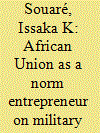

|
|
|
|
|
| Publication |
2014.
|
| Summary/Abstract |
Between 1952 and 2012, there were a total of 88 successful military coups in Africa. Of those, 63 occurred prior to 1990, and 10 cases since the adoption, by the defunct Organization of African Unity (OAU), of the Lomé Declaration in July 2000, banning military coups and adopting sanctions against regimes born out of this. The article shows that the African Union (AU) has followed in the footsteps of the OAU in this regard. Assisted by some African regional organisations and international partners, the combined effect of this policy of the AU - assisted by other factors - has been a significant reduction in the occurrence of this phenomenon. While not constituting a funeral arrangement for military coups in the immediate future, these developments - if they were to continue - may indeed make this eventuality achievable in the long run. But the article also reveals some challenges the AU is facing in ensuring this.
|
|
|
|
|
|
|
|
|
|
|
|
|
|
|
|
| 2 |
ID:
132400
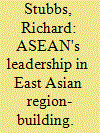

|
|
|
|
|
| Publication |
2014.
|
| Summary/Abstract |
Despite none of its members being a major economic or military power, the Association of Southeast Asian Nations (ASEAN) has played a leading role in building East Asia's regional institutions. In exploring this apparent puzzle, the analysis reviews the literature on state leadership at the regional and international level, asks why the region's major powers ceded leadership on the question of regional institution building to ASEAN, and assesses the consequences for East Asia's regional architecture of ASEAN's leadership role in institution-building. The conclusion is that leadership at the state level entails a state, or a group of states, proposing, executing and getting others to agree on a course of action to deal with a specific problem or challenge. The analysis also underscores the point that, while ASEAN has been the leader in East Asian institution-building, the Association and its members should not automatically be expected to play a leadership role on all issues preoccupying the region.
|
|
|
|
|
|
|
|
|
|
|
|
|
|
|
|
| 3 |
ID:
133899
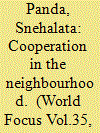

|
|
|
|
|
| Publication |
2014.
|
| Summary/Abstract |
Integration with global market economy expanded India's relationship with a wide range of countries across continents. It should be sustained and expanded along with the regional cooperation forums to strengthen economy and territorial as well as human security.(38) SAARC is the first in the series of regional cooperation organizations preceding economic reforms in India. At the moment except ASEAN and BRICS all other institutions have a lackluster performance.
|
|
|
|
|
|
|
|
|
|
|
|
|
|
|
|
| 4 |
ID:
104053
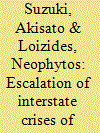

|
|
|
|
|
| Publication |
2011.
|
| Summary/Abstract |
This article examines the causation and extent of interstate crisis escalation among two conflictual dyads, namely Greece-Turkey and India-Pakistan. It draws from the International Crisis Behaviour dataset to present a new sub-dataset of 12 interstate crises involving the two dyads in the period 1987 to 2002. While crisis behaviour in Greece-Turkey has frequently been analysed within the context of two major regional organizations (NATO and the EU), Indian-Pakistani crises have been studied within the perspective of nuclear proliferation. To examine the linkage between these features and interstate crises, the article operationalizes the security dilemma and the diversionary theory of war through a probabilistic model. Using Ragin's (2000) comparative qualitative analysis, it demonstrates that both the security dilemma and diversionary theory explain crisis escalation, although the latter covers more cases with a smaller margin of error. Moreover, the article demonstrates that Greek-Turkish crises have generally escalated to relatively low levels of conflict (threat of war or show of force), while Indian-Pakistani crises have spiralled to higher levels of confrontation (use of force). In both dyads, nuclear weapons and regional organizations have shaped the boundaries of possible escalatory action. The EU and NATO have contributed to mitigating crisis escalation and the use of force between the Aegean neighbours, while unintentionally encouraging low intensity confrontations; meanwhile, in South Asia, nuclear weapons in combination with fragile domestic regimes have exacerbated crises, particularly in the form of state-sponsored unconventional warfare.
|
|
|
|
|
|
|
|
|
|
|
|
|
|
|
|
| 5 |
ID:
128238
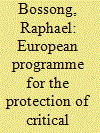

|
|
|
|
|
| Publication |
2014.
|
| Summary/Abstract |
Critical infrastructure protection (CIP) constitutes a paradigmatic as well as challenging case for EU security governance, which has received limited academic attention to date. This article draws on a heuristic framework to survey the EU's capacities to 'meta-govern', that is, to stimulate and steer governance efforts across multiple sectoral and political divides, in this complex issue area. The main part of the paper assesses the European Programme for Critical Infrastructure Protection (EPCIP), which comprises a variety of policy instruments and initiatives, on this basis. It is shown that the attempt of an authoritative regulation of European critical infrastructures has remained narrow and of questionable effectiveness. Scientific networks have developed more dynamically, while the participation of private companies and corresponding EU financial instruments are yet to show their potential. Finally, the EU's organizational capacity in CIP suffers from a lack of coordination structures in the European Commission, but also needs to take the scarcely known Joint Research Centre (JRC) into account. The conclusions highlight the barriers to comprehensive governance of as well as large research gaps on European critical infrastructure policies
|
|
|
|
|
|
|
|
|
|
|
|
|
|
|
|
| 6 |
ID:
132075


|
|
|
|
|
| Publication |
2014.
|
| Summary/Abstract |
South Korea's diplomatic and security focus has inevitably been on northeast Asia and its difficult relationship with its northern neighbour, but South Korea also has a role to play in the broader Asian Pacific region. This article analyzes South Korea's increasing economic, political, and cultural links with the wider region, in particular with Southeast Asia, and its role in the development of Asian Pacific regionalism. Utilizing the concept of "middle power," it argues that, while clearly South Korea cannot ignore what is happening in its immediate geographical environment of North-east Asia, it does have the economic and political resources to enable it to take advantage of the opportunities for greater interactions with other parts of the Asian Pacific region, particularly Southeast Asia, if the political will exists.
|
|
|
|
|
|
|
|
|
|
|
|
|
|
|
|
| 7 |
ID:
132401


|
|
|
|
|
| Publication |
2014.
|
| Summary/Abstract |
Indonesia is often regarded as the natural leader of the Association of Southeast Asian Nations (ASEAN) in light of its geographical dimensions, large population, strategic position and natural resources. The country has felt entitled to a position of leadership and has generally been recognized by the other ASEAN members as first among equals. While the de facto leadership of Indonesia has traditionally been accepted as conventional wisdom, little attention has been given to the extent to which Jakarta has actually succeeded in exercising leadership in ASEAN and how its attempt to do so has been perceived by the other Southeast Asian states. The paper explores this question by focusing on Indonesia's ability to provide international public goods in the areas of security and economics, engage in conflict management and promote institution building. It argues that the country has sought to establish a stable and autonomous security environment, to conduct conflict meditation efforts in the Cambodian conflict and the South China Sea disputes, and to develop institutional mechanisms to promote security, democracy and human rights among other issues. Still, Indonesia's leadership in ASEAN has been incomplete due to resistance from some members to its preference for an autonomous regional order and in recent years a democratic form of domestic governance. Its leadership has so far also been limited to the political and security spheres, leaving other sectors, like the economy, to others.
|
|
|
|
|
|
|
|
|
|
|
|
|
|
|
|
| 8 |
ID:
127774
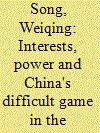

|
|
|
|
|
| Publication |
2014.
|
| Summary/Abstract |
The Shanghai Cooperation Organization (SCO)-an organization interpreted in various ways-officially announced that it intended to ensure regional security by countering international terrorism, ethnic separatism and religious extremism. This article discerns the motivations of the SCO members, arguing that they have their respective, albeit occasionally mutual, interests and priorities. There is generally asymmetry of interests-the principal reason why the SCO's strategic situation is largely a suasion game between China and the members-with China demonstrating a greater interest in the SCO; moreover, the power asymmetry between China and the Central Asian members and the power equality between China and Russia further complicates the situation. This sophisticated relationship implies that despite some measurable results, the SCO faces tremendous challenges in becoming a well-established regional organization.
|
|
|
|
|
|
|
|
|
|
|
|
|
|
|
|
| 9 |
ID:
132399
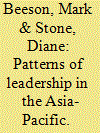

|
|
|
|
|
| Publication |
2014.
|
| Summary/Abstract |
Leadership at the regional level has come under the spotlight not only in the post-Cold War context, but also more recently following the global financial crisis. Yet, leadership by states within region-building and regional associations as leaders vis-à-vis other regions or powers remains relatively new territory for analysis and consideration, even though the Association of Southeast Asian Nations (ASEAN) has attracted both admirers and sceptics. This introductory essay is intended to achieve two principal objectives regarding this symposium addressing Asia-Pacific regional leadership. First, we seek to put the 'Asia-Pacific' in historical context and identify some of the forces that have not only shaped but also hindered its realization. Recognizing China's historical role and contemporary rise is important to understand the parameters within which ASEAN and its member states seek to define particular visions of regional identity and enact collective enterprises. The other key background consideration when thinking about contemporary leadership in the Asia-Pacific is that the United States is seemingly in decline. The Asia-Pacific's two most consequential powers - the United States and China - are pervasive considerations for any regional organization that aims to lead and promote cooperation to solve collective action problems.
|
|
|
|
|
|
|
|
|
|
|
|
|
|
|
|
| 10 |
ID:
139362
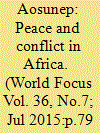

|
|
|
|
|
| Summary/Abstract |
The state of peace and security poses several continuing challenges in the African continent, which has its roots in the history. Besides the steady progress of African Union’s (AU) achievements, the continent is still faced with certain incessant conflicts. While the efforts of AU and the regional organisations are appreciative, yet due to paucity of funds of many African countries including the AU itself, many a time faced with obligation of providing maximum thrust in performing their task.
|
|
|
|
|
|
|
|
|
|
|
|
|
|
|
|
| 11 |
ID:
091685
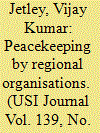

|
|
|
| 12 |
ID:
128239
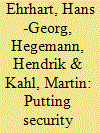

|
|
|
|
|
| Publication |
2014.
|
| Summary/Abstract |
Security governance has featured prominently in recent debates about fragmentation, informalization, and privatization in the increasingly diverse field of security policy. It has inspired much valuable research. Yet, there are not just very different conceptual understandings of security governance; there is also a lack of clarity regarding its empirical manifestations and normative connotations. After a decade of research, the special issue therefore puts security governance to the test and scrutinizes its analytical and political pitfalls and potentials. This editorial briefly reviews the rise of security governance, identifies central conceptual, empirical, and normative challenges that need to be addressed, and introduces the individual contributions to this special issue.
|
|
|
|
|
|
|
|
|
|
|
|
|
|
|
|
| 13 |
ID:
141594
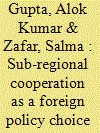

|
|
|
|
|
| Summary/Abstract |
Several factors have acted as bottleneck towards regional integration within South Asian Association for Regional Cooperation (SAARC). It ranges from Indo-Pak hostility and motivated Chinese interventions to ‘big brother small brother’ syndrome within the region. Accordingly, economic integration at the behest of SAARC as a Regional Organization has always been questioned and has largely been rendered failure. South Asia is the fastest growing region in the world. The combined economy of the SAARC countries is the third largest in the world in terms of GDP (PPP), with US and China ahead of it. According to South Asia Economic Focus report brought out by World Bank, regional growth is projected to increase from 7 percent in 2015 to 7.6 percent by 2017 with the increase in investments and steady rise in consumption patterns.
|
|
|
|
|
|
|
|
|
|
|
|
|
|
|
|
| 14 |
ID:
132402
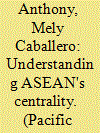

|
|
|
|
|
| Publication |
2014.
|
| Summary/Abstract |
There have been a number of articles about ASEAN's centrality in the regional security architecture of Asia. Yet, the notion of centrality remains undefined and under-operationalised. Implicit in the discourses of centrality is the idea of ASEAN's leadership, which in turn raises questions about ASEAN's ability to do so, given its limited capacity. This article defines ASEAN's centrality from the perspective of social network approach and argues that ASEAN's structural position in the density of networks that it has established and those that it has linkages with explains ASEAN's centrality. Despite its lack of material power, ASEAN has been able to claim centrality because of its position as a node in a cluster of networks, and this condition of 'high betweenness' allows ASEAN to exercise influence in regional processes with the tacit acceptance of major powers. However, while centrality may have been achieved, maintaining centrality in a rapidly changing regional environment compels ASEAN to address challenges to its centrality. This would necessarily include its ability to maintain consensus, carry out collective action and achieve its stated goals.
|
|
|
|
|
|
|
|
|
|
|
|
|
|
|
|
|
|
|
|
|